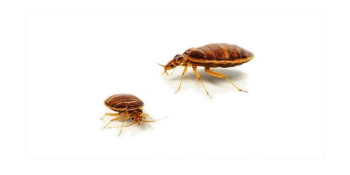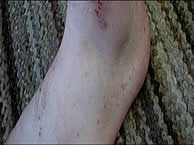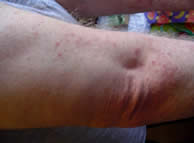Home Pest Guide Bed Bug

Description
The common bed bug, Cimex lectularius L. is a small insect (adult about 1/4 inch long). It usually has reddish brown color, flattened body from top to bottom and reduced wings. It has piercing, sucking mouthparts and feeds externally on warm blooded animals, including human.
Distribution
Recently, bed bug infestations have dramatically increased in the USA and worldwide. This is thought to be due to a number of reasons such as: traveling from infested areas, second hand furniture, used clothing, decreased use of broad spectrum residual pesticides for structural pest management in residential areas and lack of bed bug education. Bed bugs can not fly, but they can survive without a blood meal for up to a year and distribute in any common types of transportation.
Importance

Although the common bed bug is a parasite of humans, it has never been proven to transmit infectious pathogens. The bed bug bite is painless, but to prevent blood from clotting, it injects an anticoagulant substance with its saliva while feeding. This substance can cause reddish, irritated itchy skin marks in 80% of people, and occasionally blisters and necrotic spots of the skin. Conversely, few people do not react to bed bug bites.
Lifecycle
Understanding the lifecycle and the ecological interactions of bed bugs and heir surrounding environment is a vital aspect in their management protocol. The lifecycle and feeding behavior of bed bugs depends on temperature conditions, i.e., bed bug nymphs and adults stop feeding at temperatures of 56°F (13°C) or below and thermal death point is 112°F (45°C). At room temperature, the complete bed bug lifecycle takes about two months and adults can live for almost four and a half months. In colder temperatures, they may live for up to two years even without a blood meal. The female bed bug lays 2-3 eggs a day throughout its life span. Eggs are very tiny, 0.03 inches long, creamy white in color and hard to see with the naked eye. The eggs are laid in sheltered places. They are sticky when first laid and are difficult to remove by vacuuming. At room temperature, they hatch within nine to ten days. Their hatching period may be expanded to a longer time in colder temperatures. The colorless newly emerged nymph goes through five nymphal developmental instars feeding only on blood. Each nymph requires at least one blood meal to develop to the next developmental instar. It needs 3-5 minutes per meal for a complete engorgement of blood. At room temperature, nymphal instars usually last one month.
Behavior, Symptoms and Habitats

The bed bugs tendency to hide allows them to go undetected for long periods of time. They normally hide during the daytime and feed at night; however, being nocturnal insects does not necessary mean that they can not feed during thedaytime. A careful inspection should be carried out to locate bed bug symptoms which include any brown to black spots of dried blood that may be accompanied by a sweetish odor, molting skins, feces and live insects stages in mattresses, box springs, cracks, crevices, holes, loose materials such as wallpaper or paint and all other hiding areas.
Related Species
Bat bugs and bird bugs belong to the same family as bed bugs. They can also attack humans when their primary hosts are not available. These insects should also be excluded from the buildings.
Guardian Services
Guardian has two service protocols for bed bug management, Thermal Remediation (Heat Treatment) Service and Traditional (Chemical Treatment) Service. Both services treat primary rooms (rooms with bed bugs present) and secondary rooms (rooms adjacent to the primary rooms where a bed bug infestation is more likely to happen). Guardian’s trained Service Specialists will conduct bed bug management procedures in the best professional manner. Request a quote today.
Thermal Remediation (Heat Treatment) Service
We highly recommend the Thermal Remediation (Heat Treatment) Service.
Client Pretreatment Preparation
- DO NOT remove infested materials from the infested room. Provide access to all infested and surrounding area. Guardian Pest Solutions Thermal Remediation Specialist will provide thorough inspection to determine pest situation.
- Remove people and pets (including fish, bird, lizard, etc.) from the treated area during service
- Open all closet, drawers and doors of all furniture (i.e., nightstand, chest, dresser, cabinet, etc.) in the treated area
- YOU MUST remove the following items:
- Aerosel cans and compressed gases
- Flammable or combustible chemical compounds, including gasoline, propane, butane and cleaners containing distillates
- Cigarette lighters, light fuel
- YOU SHOULD remove the following items:
- Candles, lipsticks, oil paintings, acrylics, pictures, crayons, paraffin wax, cosmetics, canning wax and art objects including raw wood objects, wooden art crafts and hand crafts assembled with hot melt glue.
- Indoor plants including seeds and bulbs
- Fruits and vegetables (these items can be placed in the refrigerator)
- Chocolates, candy, medicines and vitamin (these items can be placed in the refrigerator)
- Carbonated beverages and any food products containing artificial sweeteners such as instant drink mixes and artificial sugars (these items can be placed in the refrigerator)
- Remote controls, audio and video tapes, CD, DVD, films and related chemicals
- Any items of value that might be damaged by temperatures ranging between 140 degrees F – 150 degrees F
- Make sure that all doors and windows are in good condition to restrict the flow of air in and out of the structure
- Make sure all ventilating, air-conditioning and dust collectors are shut off. A Guardian Pest Solutions Thermal Remediation Specialist will seal off these systems with plastic sheeting and tape. However, in the event of damaged paint/wallpaper, property manager/owner is responsible for needed repair.
- ALL electrical equipment, such as computer, televisions, etc. MUST BE powered down and unplugged from wall outlets.
- Shut off fire alarms and home security system, if necessary; notify your security system provider
- Fans will be used to aid the circulation of hot air throughout the treated area, therefore, remove all loose items (i.e. paper) that may be drifted around by air movement
- Stringed instruments including pianos may be de-tuned by the heat. It is your responsibility to have these instruments re-tuned
- If not readily available, secure a parking spot for the power source trailer close to the treated area
- The heating process will take 6-8 hours and will be monitored using a wireless sensing system during the entire time. Please make every effort to provide a secured location close to the treatment site for progress monitoring.
Precautionary Measures
- During the treatment, no people or pets should have access in the areas to be treated except Guardian Pest Solutions Thermal Remediation Specialist
- Do not enter the treated area for four hours after the treatment
Post Treatment Information
- Follow up evaluation is necessary 7-10 days after the treatment to ensure that the bed bugs have been eliminated. A third inspection may also be necessary. The necessity of this inspection will be determined by the results of the second inspection.
- If bed bugs are seen, please be very accurate as to where you are seeing them, how many you see, what stages you are seeing and if they are dead or alive.
Traditional (Chemical Treatment) Service
Client Pretreatment Preparation
- Make rooms accessible, take beds apart, have the mattresses and box spring accessible for inspection by the Guardian Pest Solutions Service Specialist. DO NOT remove them from the infested room.
- Remove all wall hangings i.e. pictures, clocks, mirrors etc. and place them in a secure area of the room to be inspected
- Collect all bedding, curtains and clothing, then bag them firmly in double plastic bags. These items cannot be treated with insecticides and must be laundered separately at a minimum temperature of 120°F and dried in a hot dryer.
- Carefully vacuum the bed bug infested room. Pay particular attention to hiding areas in seams, tufts, edges of head boards, night stands, behind and on pictures, mattresses, box springs, furniture, carpet edges, floorboards, loose wall paper, light switches, doors and window frames. DO NOT use the same vacuum in adjacent rooms.
- Immediately collect the vacuum contents and carefully place them in a tightly sealed double trash bag. These bags should be disposed of outside the building in a proper dumpster.
- We recommend throwing infested mattresses and box springs away.
- After the Guardian Service Specialist treats these items with an EPA registered fast knockdown capability product to eliminate bed bug distribution, carefully place mattresses and box springs in tightly sealed double plastic bags or disposable encasements (encasement can be purchased through Guardian) then discard outside the building in a proper dumpster.
- New mattresses and box springs should be encased before use with special encasements manufactured to help in the prevention of bed bug infestations (encasements can be purchased through Guardian)
- If clients choose to keep their mattresses and box springs, they should be treated with EPA registered residual insecticides, labeled for this purpose. When rooms are bed bug free, the following steps should be followed by the client:
- Make sure mattresses and box springs are completely dried
- Carefully vacuum mattresses and box springs (use rubber gloves to protect your skin from pesticide contact)
- Use mattress and box spring encasements (these can be purchased through Guardian) to avoid direct contact with the residual insecticide and to trap any bed bugs that may have been missed or will hatch after the treatment.
- Mattresses should be covered with clean linens before use.
Precautionary Measures
- During the treatment, no people, food, or pets should be present in the room to be treated. Fish tanks should be covered and the air shut off. Plants will not be affected.
- Do not enter the treated room for four hours after the treatment. Do not reoccupy and/or use before 14 days (hotels and motels only).
- Anyone with a respiratory condition should notify property manager and the Guardian Service Specialist
Post Treatment Information
- Follow up evaluation is necessary 7-10 days after the treatment to ensure that the bed bugs have been eliminated. A third inspection may also be necessary. The necessity of this inspection will be determined by the results of the second inspection.
- Primary rooms should not be reoccupied for a minimum of 14 days at room temperature of 70°F
- If bed bugs are seen, please be very accurate as to where you are seeing them, how many you see, what stages you are seeing and if they are dead or alive





